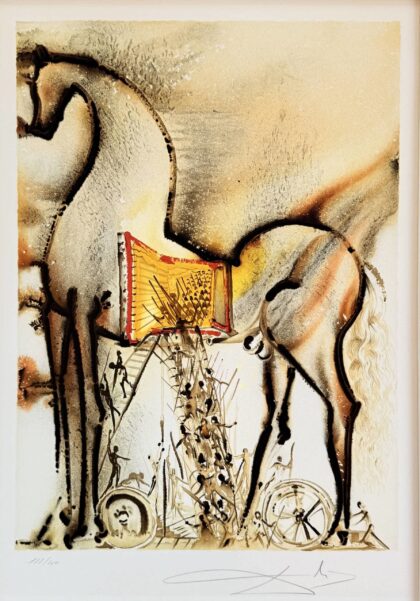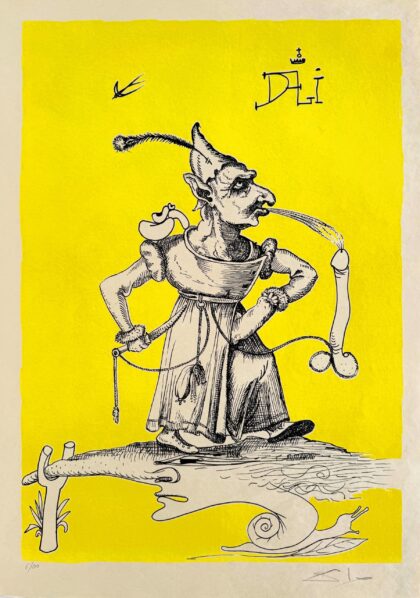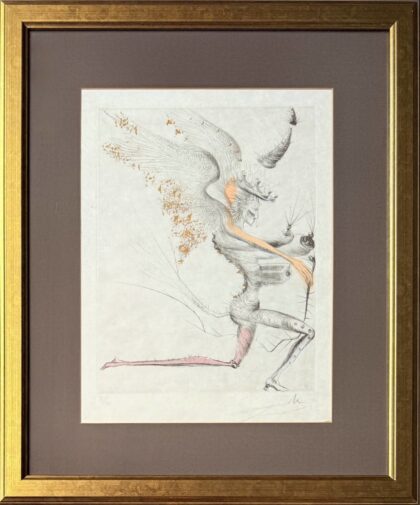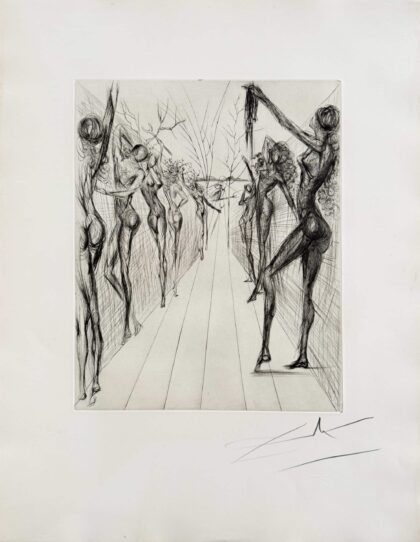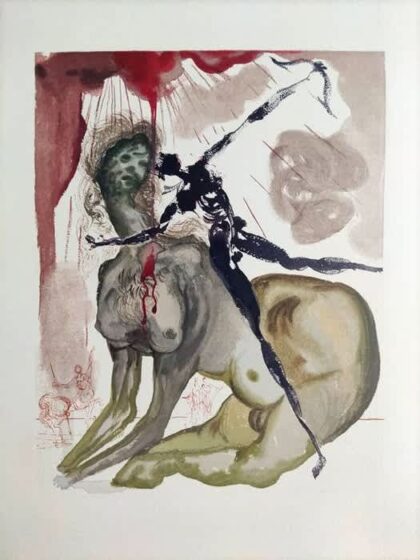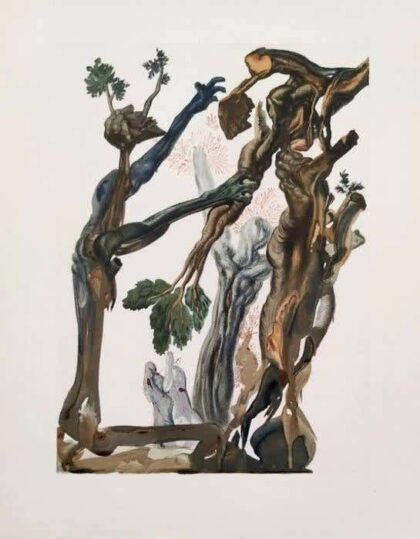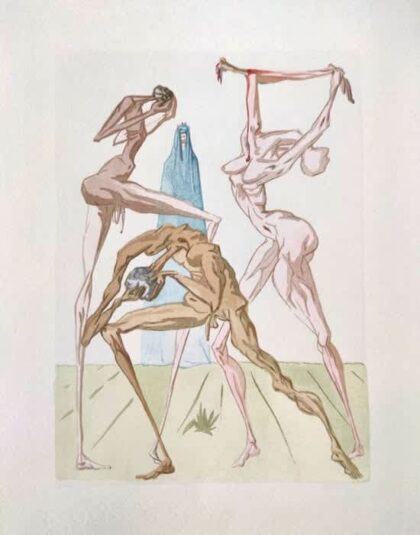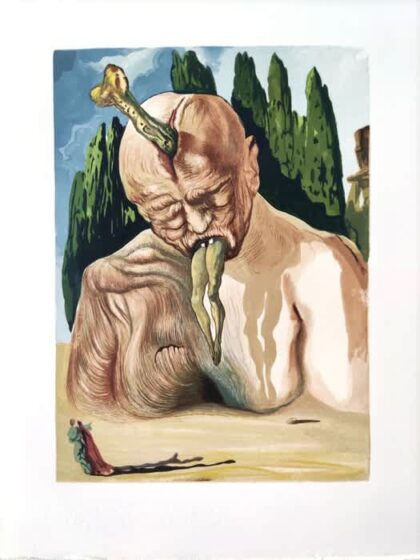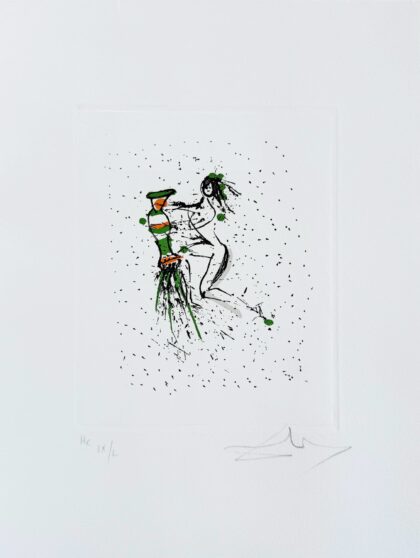Salvador Dalí (1904–1989) was a Catalan Surrealist and one of the most influential artists of the twentieth century. Celebrated for technical precision and dreamlike imagery, he forged a distinctive visual language that bridged classical craft and avant-garde imagination.
Working across painting, sculpture, film, and especially printmaking, Dalí created landmark cycles illustrating literary classics such as Dante’s Divine Comedy, Cervantes’ Don Quixote, and Lautréamont’s Les Chants de Maldoror. These works, realized as etchings, lithographs, and wood engravings, translate his surreal iconography into finely crafted graphic art.
Dalí’s prints—often produced with leading European workshops—remain sought after by collectors for their virtuosity and narrative power. His enduring legacy as a Surrealist icon and master printmaker continues to shape modern visual culture.
Collections & Illustrated Series
Explore our collection from Dalí’s major graphic cycles:
Individual works
Flordali, 1969
Dalinean Horses, 1970/72
Les Songes Drôlatiques de Pantagruel, 1973
After 50 Years of Surrealism, 1973
Poèmes Secrets, 1967
Venus aux Fourrures, 1969
Faust, 1969
The Hippies, 1969-70
Published in Paris by Pierre Argillet between 1969 and 1970, The Hippies is among Salvador Dalí’s most lyrical late graphic suites — a visionary interpretation of the 1960s spirit of freedom and inner transformation. The portfolio comprises eleven drypoint etchings with hand coloring, printed at Atelier Robbe on Arches and Japon nacré paper.
The tirage consisted of 245 examples plus 24 proofs: impressions numbered 1/145–145/145 on Arches, and deluxe copies marked I/C–C/C on Japon nacré. Each work is hand-signed in pencil by the artist and bears his blindstamp, testifying to the close collaboration between Dalí and his publisher Pierre Argillet.
In this series, Dalí transforms the countercultural ethos of the late 1960s — love, spirituality, and the search for transcendence — into a private mythology of metamorphosis. Human forms merge with air, water, and light, reflecting the passage from material existence to the realm of imagination. Technically refined and visually meditative, the suite bridges surrealism and the age of psychedelia, capturing an era’s utopian longing through Dalí’s timeless dream language.
The Hippies stands as a testament to Dalí’s enduring fascination with the invisible — a vision where body and spirit dissolve into one luminous, boundless continuum.
Divine Comedy, 1960
The Zodiac II, 1974
The Zodiac II is a refined portfolio of twelve original etchings with color, created from a single original drawing and published by Leon Amiel in Paris and New York. Each etching measures approximately 21.2 × 18 cm on a sheet of 35 × 26.2 cm and reflects the enduring dialogue between art and astrology. Printed in a limited tirage of 550 copies plus E.A., the edition includes impressions on Guarro and Japon paper, each sheet bearing the blind stamp LA as a mark of authenticity and quality.
The portfolio visualizes the twelve astrological signs, transforming celestial archetypes into symbolic compositions of line, balance, and tone:
- Aries – symbol of initiative and vitality.
- Taurus – representing stability and endurance.
- Gemini – sign of intellect and communication.
- Cancer – reflecting emotion and protection.
- Leo – emblem of strength and creativity.
- Virgo – linked to observation and discipline.
- Libra – symbol of harmony and proportion.
- Scorpio – embodying intensity and transformation.
- Sagittarius – associated with exploration and philosophy.
- Capricorn – expressing ambition and perseverance.
- Aquarius – figure of innovation and progress.
- Pisces – connected to imagination and empathy.
Each etching in The Zodiac II presents a visual meditation on the passage of time, human character, and cosmic order. The collection unites technical precision with symbolic depth, demonstrating the publisher’s dedication to fine printmaking.
The series stands as a testament to Leon Amiel’s vision, integrating modern etching techniques with the universal imagery of astrology. Through elegant composition and subtle color, these works bridge mythology, psychology, and art, offering a timeless interpretation of the zodiac that continues to resonate with collectors and scholars alike.
Japanese Fairy Tales, 1974
Japanese Fairy Tales is a rare and beautifully crafted portfolio of ten original etchings with stencil color (Rigal), created through a collaboration between Gerschmann, Stockholm and Yayoi, Tokyo. Printed in a limited tirage of 300 copies on fine Arches and Richard de Bas paper, this collection unites exquisite craftsmanship with timeless storytelling. Each etching measures approximately 48 × 38.3 cm and showcases the precision, color, and balance that define modern printmaking at its finest.
The portfolio visualizes ten iconic stories from traditional Japanese folklore, merging narrative depth with refined artistic technique. Each etching celebrates a classic tale known for its moral, symbolism, and cultural resonance:
- Momotaro (Peach Boy) – the brave child born from a peach who defeats demons with courage and loyalty.
- Hagoromo (The Robe of Feathers) – a celestial maiden’s tale of love, loss, and the link between heaven and earth.
- Urashima Taro – the fisherman who visits an underwater kingdom and discovers time’s mysterious passage.
- Hanasakaji San (The Old Man Who Made Trees Blossom) – a story of kindness rewarded through nature’s magic.
- Rokujiso (The Grateful Statues) – a parable of compassion and gratitude that transcends the material world.
- Kumo (The Weaver Spider) – a poetic reflection on patience, artistry, and fate.
- Kosonaga Chojo (The Princess and the Herd Boy) – the romantic legend of two lovers separated by the Milky Way.
- Jugoyoe – a mysterious narrative evoking Japan’s spiritual traditions and moonlit myths.
- Shunboshi (Little One-Inch) – the miniature hero who triumphs over challenges with wit and courage.
- Shitakiri (The Tongue-Cut Sparrow) – the moral tale of greed and humility, reminding viewers of life’s true values.
These Japanese etchings preserve Japan’s ancient tales through a Western fine-art technique, harmonizing Japanese folklore with European printmaking mastery. The collaboration between Yayoi Tokyo and Gerschmann Stockholm bridges cultures, offering a collection that is both visually refined and emotionally timeless.
Each print in Japanese Fairy Tales serves as a poetic interpretation of universal themes — courage, compassion, love, and humility — making this portfolio a cherished example of cross-cultural art and a lasting celebration of storytelling through the art of etching.
Images will be added soon
